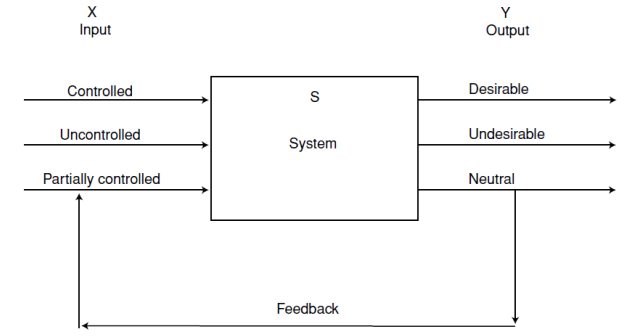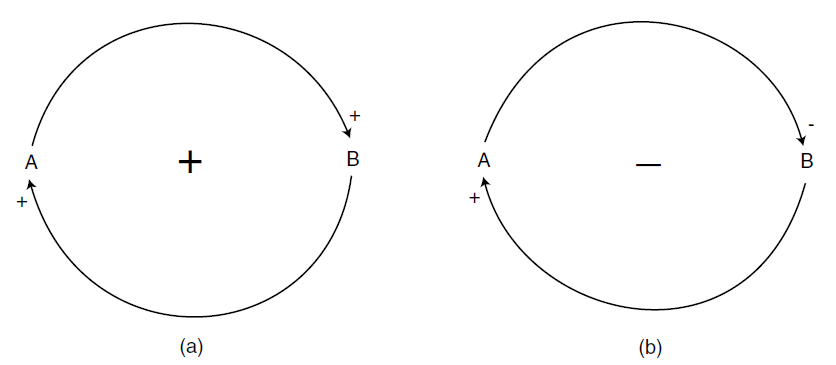By: Slobodan P. Simonovic
Reported by: Tarinee Thongcharoen (M1)
Part 2 / Systems analysis for integrated management of disasters: Chapter 3 / Systems thinking and integrated disaster management
Summary
The systems approach is a general problem-solving technique that brings more objectivity to the disaster management processes. All the methods and tools that are going to be presented here share the basic assumption that the problem task they tackle is to select an efficient means of achieving a known and define end. A system is a collection of various structural and nonstructural elements that are connected and organized in such a way as to achieve some specific objective through the control and distribution of material resources, energy, and information. A schematic representation of the system definition is shown in Figure 3.1. Input energizes the operation of a given transformation process. The final state of the process is known as the output. Feedback is the name given to a number of operations that compare the actual output with an objective and identify the discrepancies between them.
Figure 3.1 Schematic presentation of a system definition
In order to be able to answer the question “how can the framework, the process, and the technologies of systems thinking be transferred to future disaster managers in a reasonable amount of time?”, It is necessary to understand these basic types of thinking.
- Dynamic thinking, Dynamic thinking skills are based on the ability to trace out patterns of behavior that change over time. They call for thinking through the underlying closed-loop processes that cycle around to produce particular situations.
- Closed-Loop Thinking, we see the problem as a set of ongoing, interdependent processes rather than as a list of one-way relations between a group of causes and another of effects. In this model, external forces tend to be viewed as precipitators rather than as causes.
- Generic Thinking, we are generally locked into thinking in terms of specifics The notion of thinking generically rather than specifically can be applied to disaster management systems.
- Structural Thinking, we must think in terms of units of measure or dimensions. The laws of physical conservation are rigorously adhered to in this domain.
- Operational Thinking, Thinking operationally means thinking in terms of how things really work not how they should work in theory, or how a model can be created by manipulating a bit of algebra and generating some convincing-looking output.
- Continuum Thinking, Continuum thinking is usually present when we work with simulation models that have been built using a continuous, as opposed to discrete, modeling approach. Discrete models are distinguished by their containing many “if, then, else”-type equations
- Scientific Thinking, Thinking scientifically means being rigorous about testing hypotheses. This process begins by always ensuring that you do in fact have a hypothesis to test. If there is no hypothesis, the experimentation process can easily degenerate into a game.
System can be differentiate into 2 types open and closed systems. An open system is one characterized by outputs that respond to inputs, but where the outputs are isolated from and have no influence on the inputs. A closed system (also known as a feedback system) is influence by its own past behavior. A feedback system has a closed-loop structure that brings results from past action of the system back to control future action. The author stated that feedback is the most important property of integrated disaster management systems. A basic premise is that there is a unifying loop concept underlying a number of superficially diverse ideas in the social sciences. loops are characterized as positive or negative. According to figure 3.2, an increase in an element A feeds around the loop and tends to cause A to increase still further; likewise a decrease in A tends to cause A to decrease still further. Similarly, a causally loop that characteristically tends to diminish or counteract a change in any one of its elements is called a negative loop. In a negative loop, an increase in A feeds around the loop and tends to cause A to slow or reverse its increase; likewise a decrease in A tends to cause A to slow or reverse its decrease.
Figure 3.2 Positive (a) and negative (b) feedback loop.
In order to obtain a way to control or manage a system, we use a mathematical model that closely represents the system. The mathematical model is solved and its solution is applied to the system. We will set up an objective function. The restrictions are often called constraints. The constants in the constraints and the objective function are called the parameters of the model. The procedure of selecting the set of decision variables, which maximizes or minimizes the objective function subject to the systems constraints, is called the optimization procedure. The following is a general optimization problem. Select the set of decision variables x1, x2, . . . , xn such that
Min or Max f (x1, x2, . . . , xn ) subject to g1(x1, x2, . . . , xn ) ≤ b1, g2(x1, x2, . . . , xn ) ≤ b2, …gm (x1, x2, . . . , xn ) ≤ bm
where b1, b2, . . . , bm are known values.
Systems may be classified for convenience and to provide insight into their wide range.
– Natural and Human-Made Systems; Natural systems are those that came into being through natural processes. Human-made systems are those in which human beings have intervened by introducing or shaping components, attributes, or relationships. Natural systems exhibit a high degree of order and equilibrium. Only recently have significant human-made systems appeared. Primitive beings had little impact on the natural world, for they had not yet developed a potent and pervasive technology, but the impact of humanity has steadily increased over time.
– Physical and Conceptual Systems; Physical systems are those that manifest themselves in physical terms. They are composed of real components, and may be contrasted with conceptual systems, where symbols represent the attributes of components. Ideas, plans, concepts, and hypotheses are examples of conceptual systems
– Static and Dynamic Systems; A static system has a structure but no activity. A dynamic system combines structural components with activity.
– Closed and Open Systems; A closed system is one that does not interact significantly with its environment. The environment only provides a context for the system. Closed systems exhibit the characteristic of equilibrium resulting from internal rigidity, which maintains the system in spite of influence from the environment. An open system allows information, energy, and matter to cross its boundaries. Open systems interact with their wider environment.
We can also classify mathematical models according to the nature of the objective function into 4 models: linear and nonlinear models, deterministic and probabilistic models, static and dynamic models and distributed and lumped parameter models. Using systems view, Mileti states that disaster losses are the result of interaction among three systems and their main subsystems: (a) the earth’s physical systems (e.g., the atmosphere); (b) human systems (e.g., population, culture,); and (c) the constructed systems (e.g., buildings, roads). Since the disaster management system comprises four linked subsystems: individuals, organizations and society, nested within the environment. They are decision makers in their own right, with a direct role in disaster mitigation, preparedness, response, and recovery. These following concepts are important in considering disaster management.
Management principle 1: To achieve sustainable management of disasters, interactions between the four subsystems, individual, organization, society, and environment, must be appropriately integrated.
Management principle 2: Two flows resource flow and, information flow , link the individual, organization, society, and environment subsystems. Value systems are the means through which different values are attached to information and resource flow.
Management principle 3: The ongoing need of subsystems for resources from one another sets the limits of their exploitation of one another and of the environment, and is a determinant of behavior within the system.
Management principle 4: Information is used by subsystems to make decisions intended to ensure fi with the needs of other subsystems and the environment.
Management principle 5: Values provide meaning to information flows which are then used to determine resource use by subsystems.
Management principle 6: The most effective management strategies for sustainable management of disasters are those that condition access to resources.
Reporter’s Own Thoughts
This chapter introduces us the basic ideas of the system, their classifications and how to adapt the mathematic model to calculate with disaster preparedness plan such as the resources allocation. The author gave the clear 3 examples of how to use the model in the book which I did not include in this summary.

